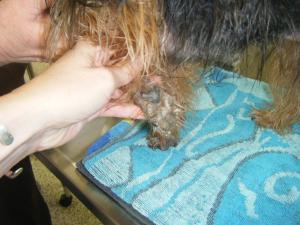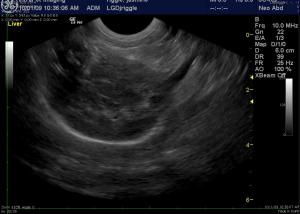Clinical Differential Diagnosis
(L. Carioto DVM, DACVIM Internal Medicine):
1. hepatocutaneous syndrom
2. erythema multiforme
3. pemphigus foleacious
4. Drug eruption
Image Interpretation
(L Yanik DVM, DACVR): The included liver is moderately hyperechoic, possessing a complex echotexture comprised of coalescing, isoechoic to hypoechoic, vascular and serosal displacing nodules separated by curvilinear echogenic foci and hyperechoic portal vascular walls.
Sonographic Differential Diagnosis
(L Yanik DVM, DACVR): These findings are compatible with an extensive infiltrative process with differentials including neoplasia such as hepatocellular carcinoma, extensive nodular hyperplasia and fibrosis associated with a chronic inflammatory process or possibly hepatocutaneous syndrome. Cirrhosis is considered less likely, given the suspected normal to increased volume of the liver.
DX
(E Lindquist DMV DABVP): No hepatic biopsy was performed. Dermal and hepatic presentation highly suggestive for clinical diagnosis of hepatocutaneous syndrome.
Outcome
Patient currently under treatment with very guarded long-term prognosis.




